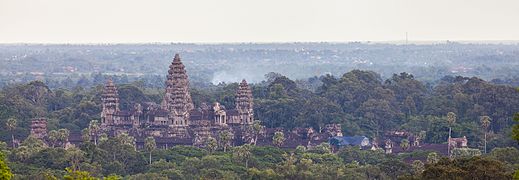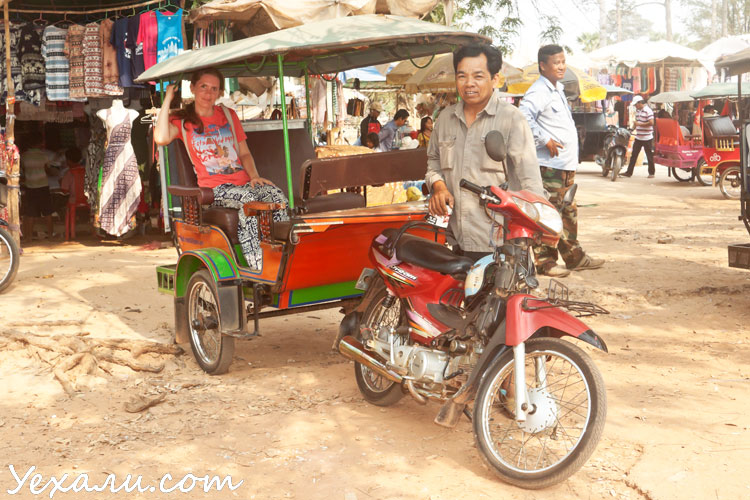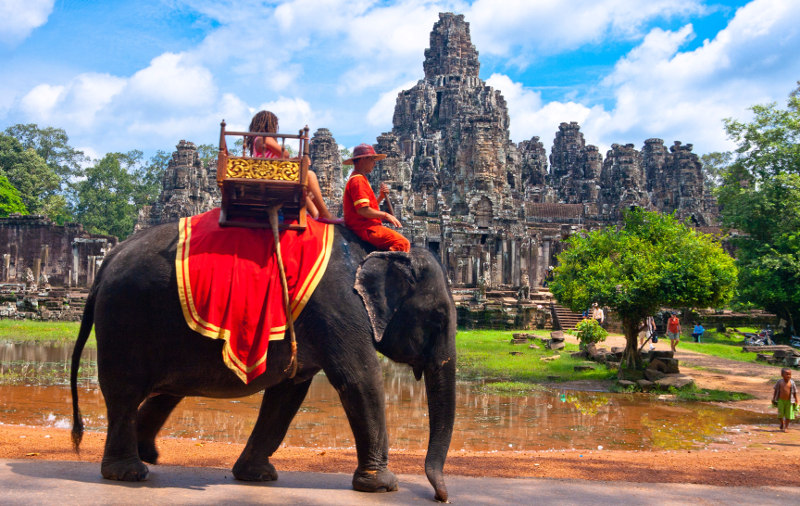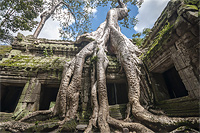Phnom Bakheng (Khmer: ប្រាសាទភ្នំបាខែង) at Angkor, Cambodia, is a Hindu and Buddhist temple in the form of a temple mountain. Dedicated to Shiva, it was built at the end of the 9th century, during the reign of King Yasovarman (889-910). Located atop a hill, it is nowadays a popular tourist spot for sunset views of the much bigger temple Angkor Wat, which lies amid the jungle about 1.5 km to the southeast. The large number of visitors makes Phnom Bakheng one of the most threatened monuments of Angkor. Since 2004, World Monuments Fund has been working to conserve the temple in partnership with APSARA.
Источник: https://en.wikipedia.org/wiki/Phnom_Bakheng
Содержание
Фото
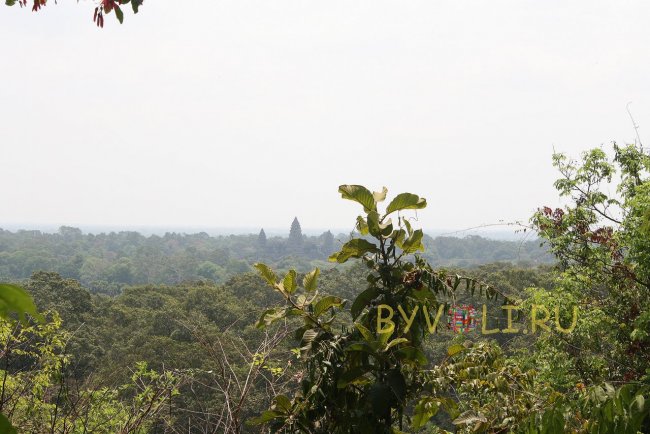

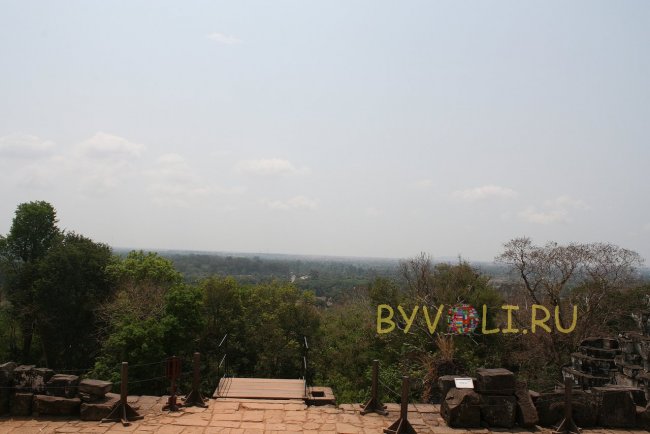
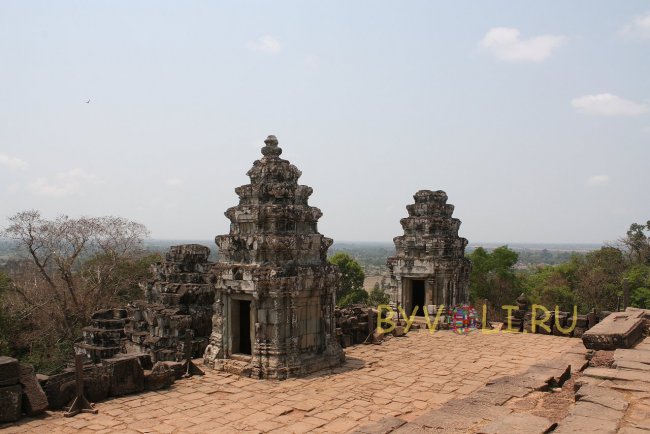
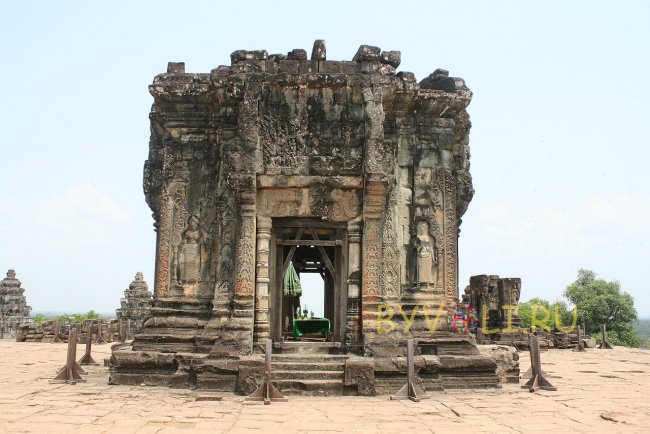
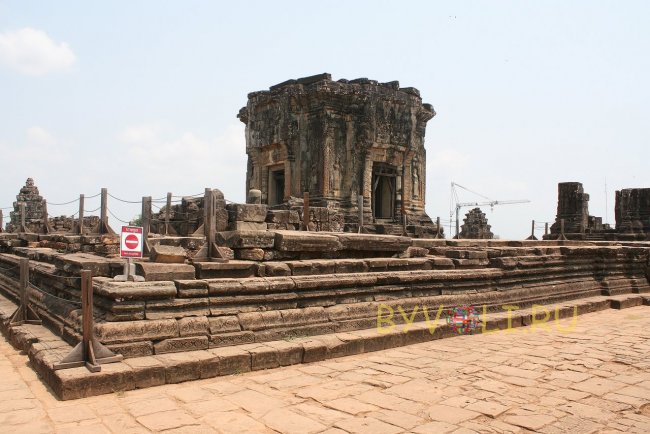
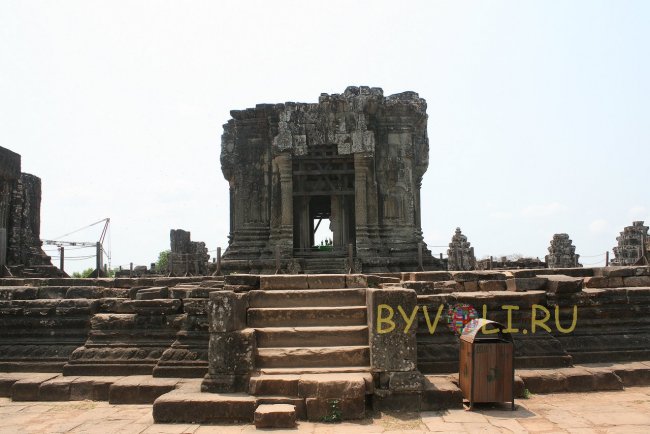
Источник: https://byvali.ru/kambodzha/angkor/phnom-bakheng
Это интересно: Крол Ко: расписываем по пунктам
History
Constructed more than two centuries before Angkor Wat, Phnom Bakheng was in its day the principal temple of the Angkor region, historians believe. It was the architectural centerpiece of a new capital, Yasodharapura, that Yasovarman built when he moved the court from the capital Hariharalaya in the Roluos area located to the southeast.
An inscription dated 1052 AD and found at the Sdok Kak Thom temple in present-day Thailand states in Sanskrit: «When Sri Yasovardhana became king under the name of Yasovarman, the able Vamasiva continued as his guru. By the king’s order, he set up a linga on Sri Yasodharagiri, a mountain equal in beauty to the king of mountains.» Scholars believe that this passage refers to the consecration of the Phnom Bakheng temple approximately a century and a half earlier.
Phnom Bakheng is one of 3 hilltop temples in the Angkor region that are attributed to Yasovarman’s reign. The other two are Phnom Krom to the south near the Tonle Sap lake, and Phnom Bok, northeast of the East Baray reservoir.
Surrounding the mount and temple, labor teams built an outer moat. Avenues radiated out in the four cardinal directions from the mount. A causeway ran in a northwest-southeast orientation from the old capital area to the east section of the new capital’s outer moat and then, turning to an east–west orientation, connected directly to the east entrance of the temple.
Later in its history, Phnom Bakheng was converted into a Buddhist temple. A monumental Sitting Buddha, now lost, was created on its upper tier. Across its west side, a Reclining Buddha of similar scale was crafted in stone. The outlines of this figure are still visible.
Источник: https://en.wikipedia.org/wiki/Phnom_Bakheng
Видео
Источник: https://byvali.ru/kambodzha/angkor/phnom-bakheng
Symbolism
Phnom Bakheng is a symbolic representation of Mount Meru, home of the Hindu gods, a status emphasized by the temple’s location atop a steep hill 65 m above the surrounding plain. The temple is built in a pyramid form of seven levels, representing the seven heavens. At the top level, five sandstone sanctuaries, in various states of repair, stand in a quincunx pattern—one in the center and one at each corner of the level’s square. Originally, 108 small towers were arrayed around the temple at ground level and on various of its tiers; most of them have collapsed.
Jean Filliozat of the Ecole Francaise, a leading western authority on Indian cosmology and astronomy, interpreted the symbolism of the temple. The temple sits on a rectangular base and rises in five levels and is crowned by five main towers. One hundred four smaller towers are distributed over the lower four levels, placed so symmetrically that only 33 can be seen from the center of any side. Thirty-three is the number of gods who dwelt on Mount Meru. Phnom Bakheng’s total number of towers is also significant. The center one represents the axis of the world and the 108 smaller ones represent the four lunar phases, each with 27 days. The seven levels of the monument represent the seven heavens and each terrace contains 12 towers which represent the 12-year cycle of Jupiter. According to University of Chicago scholar Paul Wheatley, it is «an astronomical calendar in stone.»
Following Angkor’s rediscovery by the outside world in the mid-19th century, decades passed before archeologists grasped Phnom Bakheng’s historical significance. For many years, scholars’ consensus view was that the Bayon, the temple located at the center of Angkor Thom city, was the edifice to which the Sdok Kak Thom inscription referred. Later work identified the Bayon as a Buddhist site, built almost three centuries later than originally thought, in the late 12th century, and Phnom Bakheng as King Yasovarman’s state temple.

Источник: https://en.wikipedia.org/wiki/Phnom_Bakheng
Ñèìâîëèçì
Õðàì Ïíîì Áàêõåíã
Êîëè÷åñòâî áàøåí â õðàìå Áàêõåíã èìååò ñèìâîëè÷åñêîå çíà÷åíèå. Èçíà÷àëüíî õðàì Ïíîì Áàêõåíã óêðàøàëè 109 áàøåí, ÿâëÿâøèåñÿ êîïèÿìè ãîðû Ìåðó, îäíàêî ìíîãèå èç íèõ íå ñîõðàíèëèñü. Íà âåðõíåé òåððàñå áûëî ðàñïîëîæåíî ïÿòü áàøåí, ïî 12 íà êàæäîì èç ïÿòè ÿðóñîâ îñíîâàíèÿ, è åùå 44 áàøíè âîêðóã îñíîâàíèÿ. Êèðïè÷íûå áàøíè ñèìâîëèçèðîâàëè 12-ãîäè÷íûé öèêë èç çíàêîâ Çîäèàêà. Çà èñêëþ÷åíèåì Öåíòðàëüíîãî ñâÿòèëèùà, 108 áàøåí ñèìâîëèçèðóþò ÷åòûðå ôàçû Ëóíû, êàæäàÿ èç êîòîðûõ äëèòñÿ 27 äíåé. Ñåìü óðîâíåé (íèæíèé, ïÿòü ÿðóñîâ è âåðõíÿÿ òåððàñà) ñîîòâåòñòâóþò ñåìè íåáåñàì â èíäèéñêîé ìèôîëîãèè.
Источник: http://tourismcambodia.ru/what_see_angkor_bakheng.html
Это интересно: Храм Прасат Краван: излагаем все нюансы
Phnom Bakheng in popular media
The view of the Angkor Wat from the top of Phnom Bakheng is featured in the movie Tomb Raider (when Lara Croft looks through the binoculars upon arriving in Cambodia).
Источник: https://en.wikipedia.org/wiki/Phnom_Bakheng
Ïëàí
Õðàì Ïíîì Áàêõåíã
Êàæäûé óãîëîê Àíãêîðà ïîëîí çàãàäîê êõìåðîâ. Çäåñü, íà ýòîì õîëìå, äàæå òåíè êàæóòñÿ òåìíåå, ïîòîìó ÷òî ñ Ïíîì Áàêõåíãîì íå ñðàâíèòñÿ íè îäíà äîñòîïðèìå÷àòåëüíîñòü Àíãêîðà.
Ïíîì Áàêõåíã èìååò êâàäðàòíóþ ôîðìó. Åãî îñíîâàíèå ñîñòîèò èç ïÿòè ÿðóñîâ (1-5) è ïÿòè ñâÿòèëèù (6-10) íà âåðõíåì óðîâíå, ðàñïîëîæåííûå â óãëàõ è â öåíòðå òåððàñû. Äëèíà êàæäîé èç ñòîðîí îñíîâàíèÿ ðàâíà 76 ìåòðîâ, à îáùàÿ âûñîòà îñíîâàíèÿ ðàâíà 13 ìåòðîâ. Íà êàæäîé ñòîðîíå îñíîâàíèÿ èìååòñÿ êðóòàÿ êàìåííàÿ ëåñòíèöà ñ íàêëîíîì â 70°. Ïî îáåèì ñòîðîíàì íà êàæäîì óðîâíå ñèäÿò ôèãóðû ëüâîâ. Äî íàøèõ äíåé ñîõðàíèëèñü îñòàòêè ñòåíû, îêðóæàâøåé õðàì, ñ áàøíÿìè ó âõîäà.
Ôèãóðû ëüâîâ âûïîëíåíû â î÷åíü ãàðìîíè÷íûõ ïðîïîðöèÿõ. Ñïðàâà èìååòñÿ íåáîëüøîå ñîîðóæåíèå ñ êîëîííàìè èç ïåñ÷àíèêà; â êà÷åñòâå ïîãðàíè÷íûõ êàìíåé âûñòóïàþò äâà ëèíãà. Áëèæå ê âåðøèíå, ïî öåíòðó äîðîæêè, èìååòñÿ îòïå÷àòîê íîãè Áóääû. Îòïå÷àòîê îêðóæåí öåìåíòíûì çàãðàæäåíèåì è çàêðûò äåðåâÿííîé êðûøåé.
Åùå áëèæå ê âåðøèíå âèäíû ðóèíû áàøíè, ÿâëÿâøåéñÿ ÷àñòüþ âíåøíåé ñòåíû. Ñóäÿ ïî ðîìáîâèäíûì îòâåðñòèÿì â ñòåíàõ, ïî îáåèì ñòîðîíàì äîðîãè ðàñïîëàãàþòñÿ äâå áèáëèîòåêè èç ïåñ÷àíèêà. Îáå áèáëèîòåêè îáðàùåíû íà çàïàä, à çàéòè â íèõ ìîæíî ñ âîñòî÷íîé ñòîðîíû.
 óãëàõ íà êàæäîì óðîâíå è ïî îáåèì ñòîðîíàì ëåñòíèöû ðàñïîëàãàþòñÿ íåáîëüøèå êàìåííûå ñâÿòûíè.
Источник: http://tourismcambodia.ru/what_see_angkor_bakheng.html
Gallery
-
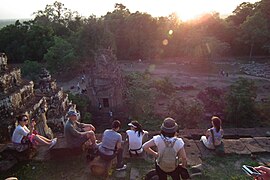
Phnom Bakheng is a viewpoint of the setting sun
-

Phnom Bakheng
-
Angkor Wat seen from Phnom Bakheng at sunset
-
General view
-
Upper terrace
-
Stone tower and Angkor Wat far afield
Источник: https://en.wikipedia.org/wiki/Phnom_Bakheng
Âåðõíèé óðîâåíü
Ïÿòü áàøåí ðàçìåùåíû â òàêîì æå ïîðÿäêå, êàê òî÷êè íà èãðàëüíîì êóáèêå.  öåíòðàëüíîé áàøíå èìåëñÿ ëèíãà, îáðàùåííûé íà ÷åòûðå ñòîðîíû.  ÷åòûðåõ îñòàëüíûõ áàøíÿõ òàêæå íàõîäèòñÿ ëèíãà íà ïüåäåñòàëå, îáðàùåííûé íà äâå ñòîðîíû.
 ðàâíîìåðíî ðàñïîëîæåííûõ îòâåðñòèÿõ â ïîëó îêîëî âîñòî÷íîé ñòîðîíû Öåíòðàëüíîãî ñâÿòèëèùà, âåðîÿòíî, íàõîäèëèñü äåðåâÿííûå êîëîííû, ïîääåðæèâàþùèå êðûøó. Öåíòðàëüíîå ñâÿòèëèùå äåêîðèðîâàíî æåíñêèìè áîæåñòâåííûìè ñóùåñòâàìè, ðàñïîëîæåííûìè ïîä ñâîäàìè óãëîâûõ êîëîíí, è àïñàðàìè ñ èçÿùíî âûðåçàííûìè âåíêàìè èç ëèñòâû íàä èõ ãîëîâàìè; Íà òèìïàíàõ ðàçìåùåíû èñêóñíî ñäåëàííûå ìàêàðû. Íà ëåâîé ñòîðîíå ñåâåðíîé äâåðè Öåíòðàëüíîãî ñâÿòèëèùà âèäíà íàäïèñü.
Источник: http://tourismcambodia.ru/what_see_angkor_bakheng.html
References
- Coedès, George (1968). Walter F. Vella (ed.). The Indianized States of Southeast Asia. trans.Susan Brown Cowing. University of Hawaii Press. ISBN 978-0-8248-0368-1.
- Goloubev, Victor. Le Phnom Bakheng et la ville de Yasovarman. Bulletin de l’EFEO (Paris), 33 (1933): 319-344.
- Goloubev, Victor. Nouvelles récherches autour de Phnom Bakhen. Bulletin de l’EFEO (Paris), 34 (1934): 576-600.
- Higham, Charles (2014). Early Mainland Southeast Asia. Bangkok: River Books Co., Ltd. ISBN 9786167339443.
- Higham, Charles (2001). The Civilization of Angkor. Bangkok: University of California Press.
- Rooney, Dawn (2002). Angkor (Fourth ed.). Airphoto International Ltd.
- Sak-Humphry, Chhany (2005). The Sdok Kak Thom Inscription. The Buddhist Institute.
Источник: https://en.wikipedia.org/wiki/Phnom_Bakheng
Количество использованных доноров: 4
Информация по каждому донору:
- https://byvali.ru/kambodzha/angkor/phnom-bakheng: использовано 2 блоков из 4, кол-во символов 43 (0%)
- http://tourismcambodia.ru/what_see_angkor_bakheng.html: использовано 5 блоков из 6, кол-во символов 12099 (58%)
- https://trip-dream-live.ru/hramy_kambodzhi_phnom_bakeng/: использовано 1 блоков из 2, кол-во символов 3315 (16%)
- https://en.wikipedia.org/wiki/Phnom_Bakheng: использовано 6 блоков из 8, кол-во символов 5497 (26%)


